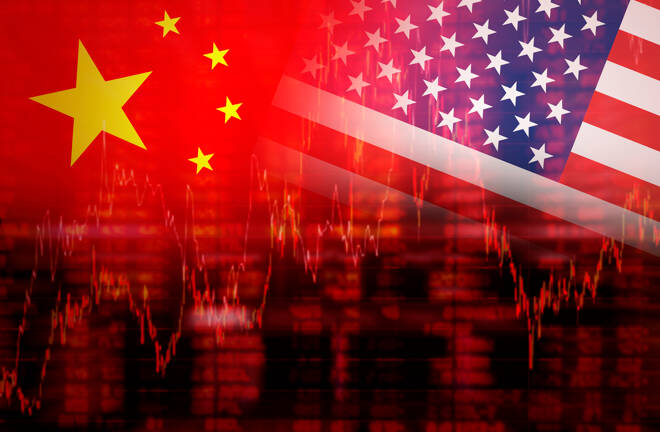Advertisement
Advertisement
China Faces Trade-Offs in Talks With US Amid Weak Demand and Export Risks
By:
Key Points:
- US-China trade talks resume in Stockholm with a 90-day truce extension amid global trade complexities.
- Trump seeks major Xi meeting, aiming for a high-profile agreement with headline-grabbing figures.
- China’s weak demand and cautious consumer behavior challenge US export push and Phase 2 goals.
Chip Curbs vs. Rare Earths: Trade Talks Test China’s Bargaining Power
On Monday, July 28, the highly anticipated third round of high-level trade talks between the US and China kicked off in Stockholm. The trade war truce previously set to expire on Tuesday, August 12, has reportedly been extended by another 90 days. The need for an extension highlighted the complexities of reaching a trade agreement, given that the US has reached trade deals with Japan and the EU.
US Treasury Secretary Scott Bessent and China’s Vice Premier He Lifeng will likely highlight key issues, including China’s manufacturing overcapacity and fentanyl supply. On the one side, the US could threaten China with new restrictions on chip supply, while China has rare earth mineral supplies to navigate talks.
Considering the terms of Japan and the EU’s trade deals, the bigger question is whether China would agree to an imbalanced deal. A 90-day extension would kick the proverbial can down the road, potentially paving the way for a meeting between President Trump and Xi Jinping to iron out potential sticking points.
Tariff Tactics: Trump’s Playbook Revisited
CBB’s Derek Scissors, Asia Economist at the American Enterprise Institute, discussed the potential for a Phase 2 deal on July 28, stating:
“If the Chinese make a deal with the United States, if they’re willing to do that, I think they understand, I think Europe understands, they’re not doing anything other than buying themselves time. Six months, a year, who knows, and that’s the major concern the Chinese have. It’s not necessarily being tough. They’ve already shown that they’re tough in the run up to these meetings. It’s that if you make a deal with the US, how long does it last?”
Discussing the potential tactics to continue extending the deadline, Scissors said:
“Right, the President, as you guys said, the President wants a meeting with Xi. […]. A big meeting not just a sideline meeting, where they come, you know, somebody comes out and gives a report of what the meeting was. He wants a big event, and he wants, you know, a big deal with lots of dollar figures involved. We’ve seen this pattern. So, they’re stalling to see if the Chinese will agree to that and whether they can announce it.”
Scissors pointed out that the phase one deal from Trump’s first term pushed for more US exports and failed. Trump could aim for the same, given that China is unlikely to invest heavily in the US.
China’s Weak Demand Conundrum
While the US may push for more exports to China, the weak domestic demand backdrop and waning external demand may affect Beijing’s willingness to import more US goods.
East Asia Econ shared a chart of China’s households, % of deposits held on demand, and highlighted Beijing’s issue of addressing weak demand and strong supply, stating:
“Does anti-involution produce macro turnaround when the September combination of stock market and local government bailout failed? The markets are hopeful. I am more cautious. I’d be wrong if household savings behavior shifts.”
The weak domestic environment could challenge Beijing’s 5% GDP growth target for 2025, given recent trade developments. US tariffs on Indonesia (19%) and transshipments from Vietnam (40%) may weigh on demand from Southeast Asia.
Exports to Southeast Asia rose 16.8% year-on-year in June, while exports to the US tumbled 16.1%. Higher tariffs on China’s key trade routes through Southeast Asia may impact trade terms and the broader economy. Despite US tariffs, China’s exports rose 5.8% year-on-year (YoY) in June, a sharp pickup from May’s 4.8% increase. Strong exports contributed to China’s 5.2% year-on-year GDP growth in the second quarter, marginally softer than the first quarter’s 5.4%, but above the 5% GDP target.
A sharp drop in exports to Southeast Asia and US tariffs on Chinese goods may pressure China’s private sector. Uncertainty about a US-China trade deal could also force Beijing to delay meaningful stimulus to bolster the economy. Addressing domestic demand could be crucial. But weakening external demand may impact the labor market, consumer sentiment, and household spending.
Given the dynamics, China may want more certainty with a balanced trade deal, but getting one may require Xi Jinping to make significant compromises.
US-China Trade Talks Fuel Uncertainty, Impacting Market Sentiment
Mainland China markets retreated in early trading on Tuesday, July 29, with the CSI 300 pulling further back from eight-month highs. However, despite the pullback, the CSI 300 and Shanghai Composite Index have posted July-to-date gains of 5.02% and 4.38%, respectively, outperforming the Nasdaq Composite Index (+3.97%). Easing trade tensions and hopes for a deal have lifted sentiment. However, uncertainty and renewed tensions could trigger a reversal, potentially exposing April’s seven-month lows.
The Hang Seng Index also retreated in early trading on Tuesday, but remained up 5.15% month-to-date.
Outlook
US-China trade headlines, China’s upcoming private sector PMIs (July 31), and Beijing’s stimulus plans will continue to influence sentiment.
Lower US tariffs on Chinese goods may lift sentiment. On the other hand, stalled talks or an imbalanced deal may weigh on Hong Kong and Mainland China’s markets. Under this scenario, Beijing’s policy responses could be pivotal in driving demand for HK and Mainland China-listed stocks.
Track our real-time updates on China trade policy and equity market trends, and consult our economic calendar.
About the Author
Bob Masonauthor
With over 28 years of experience in the financial industry, Bob has worked with various global rating agencies and multinational banks. Currently he is covering currencies, commodities, alternative asset classes and global equities, focusing mostly on European and Asian markets.
Advertisement
